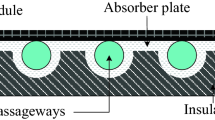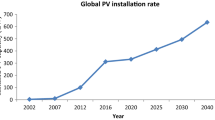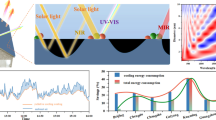Abstract
Thermal performance of a solar volumetric receiver incorporating the different cell geometric configurations is investigated. Triangular, hexagonal, and rectangular absorbing cells are incorporated in the analysis. The fluid volume fraction, which is the ratio of the volume of the working fluid over the total volume of solar volumetric receiver, is introduced to assess the effect of cell size on the heat transfer rates in the receiver. In this case, reducing the fluid volume fraction corresponds to increasing cell size in the receiver. SiC is considered as the cell material, and air is used as the working fluid in the receiver. The Lambert’s Beer law is incorporated to account for the solar absorption in the receiver. A finite element method is used to solve the governing equation of flow and heat transfer. It is found that the fluid volume fraction has significant effect on the flow field in the solar volumetric receiver, which also modifies thermal field in the working fluid. The triangular absorbing cell gives rise to improved effectiveness of the receiver and then follows the hexagonal and rectangular cells. The second law efficiency of the receiver remains high when hexagonal cells are used. This occurs for the fluid volume fraction ratio of 0.5.













Similar content being viewed by others
References
S.-H. Lee, S.P. Jang, Efficiency of a volumetric receiver using aqueous suspensions of multi-walled carbon nanotubes for absorbing solar thermal energy. Int. J. Heat Mass Tran. 80, 58–71 (2015)
A. Veeraragavan, A. Lenert, B. Yilbas, S. Al-Dini, E.N. Wang, Analytical model for the design of volumetric solar flow receivers. Int. J. Heat Mass Tran. 55, 556–564 (2012)
B.S. Yilbas, O.S. Kaleem, Performance characteristics of a volumetric solar receiver: presence of an absorber plate with a selective surface. Numer. Heat Transf. Part A-Appl. 67, 992–1009 (2015)
M.I. Roldán, O. Smirnova, T. Fend, J.L. Casas, E. Zarza, Thermal analysis and design of a volumetric solar absorber depending on the porosity. Renew. Energ. 62, 116–128 (2014)
S. Palero, M. Romero, J.L. Castillo, Comparison of experimental and numerical air temperature distributions behind a cylindrical volumetric solar absorber module. J. Sol. Energy-Trans ASME 130, 011011 (2008)
A. Kribus, Y. Gray, M. Grijnevich, G. Mittelman, S. Mey-Cloutier, C. Caliot, The promise and challenge of solar volumetric absorbers. Sol. Energy 110, 463–481 (2014)
X. Chen, X. Xia, X. Dong, G. Dai, Integrated analysis on the volumetric absorption characteristics and optical performance for a porous media receiver. Energy Convers. Manag. 105, 562–569 (2015)
V. Khullar, H. Tyagi, N. Hordy, T.P. Otanicar, Y. Hewakuruppu, P. Modi, R.A. Taylor, Harvesting solar thermal energy through nanofluid-based volumetric absorption systems. Int. J. Heat Mass Transf. 77, 377–384 (2014)
H.-J. Lee, J.-K. Kim, S.-N. Lee, Y.-H. Kang, Consistent heat transfer analysis for performance evaluation of multichannel solar absorbers. Sol. Energy 86, 1576–1585 (2012)
A.L. Avila-Marin, Volumetric receivers in solar thermal power plants with central receiver system technology: a review. Sol. Energy 85, 891–910 (2011)
Z. Wu, C. Caliot, G. Flamant, Z. Wang, Coupled radiation and flow modeling in ceramic foam volumetric solar air receivers. Sol. Energy 85, 2374–2385 (2011)
O.K. Siddiqui, B.S. Yilbas, Thermal characteristics of a volumetric solar absorption system. Int. J. Energy Res. 38, 581–591 (2014)
A. Lenert, E.N. Wang, Optimization of nanofluid volumetric receivers for solar thermal energy conversion. Sol. Energy 86, 253–265 (2012)
M.I. Roldán, R. Monterreal, Heat flux and temperature prediction on a volumetric receiver installed in a solar furnace. Appl. Energy 120, 65–74 (2014)
H. Wang, V.P. Sivan, A. Mitchell, G. Rosengarten, P. Phelan, L. Wang, Highly efficient selective metamaterial absorber for high-temperature solar thermal energy harvesting. Sol. Energy Mat. Sol. C. 137, 235–242 (2015)
Y.L. Hewakuruppu, R.A. Taylor, H. Tyagi, V. Khullar, T. Otanicar, S. Coulombe, N. Hordy, Limits of selectivity of direct volumetric solar absorption. Sol. Energy 114, 206–216 (2015)
Z. Wu, Z. Wang, Fully coupled transient modeling of ceramic foam volumetric solar air receiver. Sol. Energy 89, 122–133 (2013)
G.L. Harris, Harris properties of silicon carbide (INSPEC (Institution of Electrical Engineering), London, 1995), pp. 15–20
R. Kitamura, L. Pilon, M. Jonasz, Optical constants of silica glass from extreme. Appl. Optics 46, 8118–8133 (2007)
Acknowledgments
The authors acknowledge the funded NSTIP project 13-ENE271-04-R via support of KACST and the Deanship of Scientific Research at King Fahd University of Petroleum and Minerals, Dhahran, Saudi Arabia, for this work.
Author information
Authors and Affiliations
Corresponding author
Rights and permissions
About this article
Cite this article
Yilbas, B.S., Shuja, S.Z. A Solar Volumetric Receiver: Influence of Absorbing Cells Configuration on Device Thermal Performance. Int J Thermophys 38, 1 (2017). https://doi.org/10.1007/s10765-016-2132-3
Received:
Accepted:
Published:
DOI: https://doi.org/10.1007/s10765-016-2132-3




